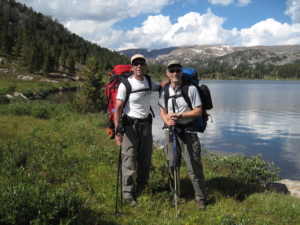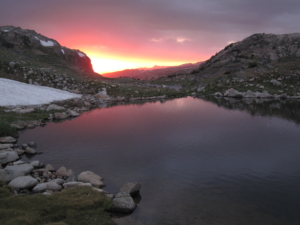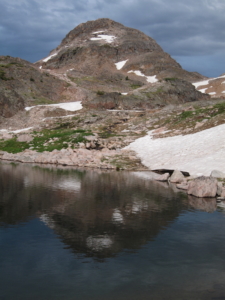Finding Your Place in Nature
“Finding a pristine place and being the only person there to witness it is quite special and a privilege.”
-Craig Groves

Craig Groves (left) and his hiking partner on their way into the Absaroka-Beartooth Wilderness in Montana
Solitude. It’s that elusive place and state of mind we seek when we slip on our packs and enter a forest or climb a mountain. For Montana resident Craig Groves, solitude is found in high elevation lake basins where he can camp for days on end without encountering a single soul.
“In many places throughout the western U.S., it’s difficult to find complete solitude because so many more people are discovering the wonders of nature,” says Craig. “While I appreciate the value of more people enjoying the outdoors, finding a pristine place and being the only person there to witness it is quite special and a privilege.”
Craig grew up far from the Montana wilderness in southern Ohio, but even at a young age, he was drawn to nature in any form, and was often found in the woods next to his house. It was here amongst the oak, walnut and maple trees that he was a frequent witness to the comings and goings of wild critters such as opossums, cardinals and chipmunks, and a careful observer of the large bee and wasp nests tucked into tree cavities. These early encounters with nature stuck with him, and at 16, he experienced his first true wilderness adventure.
“When I was 16, a friend and I trudged off to Sears and purchased our first backpacks, tents, and sleeping bags and headed off for our first backpacking trip on the Appalachian Trail through the Great Smoky Mountains National Park,” recalls Craig. “It was a big adventure and much more arduous than we anticipated. Our gear was laughably heavy right down to our massive leather hiking boots. One of the highlights of the trip was seeing my first radio-collared black bears and learning for the first time how scientists were studying bears in this national park.”
Craig admits that first backpacking trip influenced his decision later in life to pursue a career in nature conservation as an ecologist and wildlife biologist. Following an undergraduate education in biology and a master’s degree in ecology, Craig was fortunate to land a job with The Nature Conservancy early in his career. “That first backpacking trip was also my impetus to move west and pursue other backcountry adventures,” adds Craig, who packed up his car and headed west to Idaho in the late 1970s.
Finding your favorite spot in nature
Everyone has a “go to” spot. That one place that speaks to us above all others because it offers familiarity with the promise of new adventure with every visit. Craig first discovered Montana’s Absaroka-Beartooth (A-B) Wilderness in 1987 and it immediately became his spot. “Over the last decade or so I have taken a backpacking trip nearly every summer into the A-B Wilderness. It’s a large wilderness and there are seemingly endless high elevation lake basins to explore,” says Craig.
The conservationist in Craig is drawn to the ecological diversity found in the A-B Wilderness. “The A-B still has all of its native species intact, which means it hasn’t lost any of the biodiversity that was there when Lewis and Clark first passed through Montana in 1805. There aren’t too many places left in the U.S. that have this sort of ecological integrity.”

The Beartooth Mountains
Designated by Congress in 1972, the 937,032-acre Absaroka-Beartooth Wilderness is located in south central Montana, with a small portion in northern Wyoming just north of Yellowstone National Park. Named for the Absaroka and Beartooth Mountain Ranges, this wilderness is dominated by sweeping tundra plateaus, deep canyons, active glaciers, sparkling streams, and hundreds of alpine lakes.
If you ask Craig why he is continually drawn to this particular wilderness, you’ll be treated to stories that emphasize his keen sense of observation. “One of my most memorable trips was about five years ago with a good friend and fly fishing partner. We were in a remote part of the wilderness, well above the tree line, when we noticed a bald eagle flying over the lake we were headed toward. That was our first hint that the lake had some good fishing. As we approached the lake, we observed something even more unusual – a family of river otters swimming in the lake. Finding river otters miles above the tree line is quite uncommon, but we soon realized that the river otters had likely followed fish all the way upstream through a series of lakes. Indeed, there were lots of really large trout in this lake, which of course made for some fun fishing.”
Montana is home to approximately 3.5 million acres of pristine wilderness within 16 designated wilderness areas. As amazing as that sounds, this wilderness is also vulnerable to more than 4,500 acres of private property (inholdings) with the potential for development and other uses that threaten to permanently alter its wildness.
In early 2019 Craig joined The Wilderness Land Trust board of directors, providing his invaluable experience as a conservationist to the organization and much needed insight to the Trust’s Lands program. With Craig’s help, the organization has continued to successfully return private properties that directly benefit wilderness values to the public for permanent protection.
“I am grateful for the opportunity to help further the Trust’s mission to protect wild places like the A-B Wilderness in Montana or the Frank Church River-of-No-Return Wilderness in central Idaho, where I have been fortunate to spend many rewarding days backpacking, river rafting, or skiing,” says Craig.

The Beartooth Mountains
Albert Einstein reminded the world to “Look deep into nature, and then you will understand everything better.” From his first foray observing opossums in his wooded backyard in Ohio to using bald eagles and otters to guide him to the best fishing spots in Montana, Craig has become a lifelong learner of nature and has spent most of his professional life helping others understand and conserve it as well.
Do you have a “go to” spot? We’d love to hear what makes it special for you. Send us an email and we’ll share it on our social media channels.
About Craig Groves
Craig is a conservation scientist and planner who retired in late 2017 as the executive director for the Science for Nature and People Partnership or SNAPP, a collaboration of The Nature Conservancy, the Wildlife Conservation Society, and the National Center for Ecological Analysis & Synthesis at University of CA Santa Barbara. He currently serves as the co-chair of the board of directors of the Yellowstone to Yukon Conservation Initiative. He is also the series editor for IUCN’s World Commission on Protected Areas (WCPA) Best Practice Guidelines. He has written and published two books on conservation planning as well as more than 50 peer-reviewed scientific articles on conservation planning, protected areas, climate adaptation, and the ecology of at-risk species. His second book, Conservation Planning: Informed Decisions for a Healthier Planet (with co-author Edward Game) was published by MacMillan in 2016.


